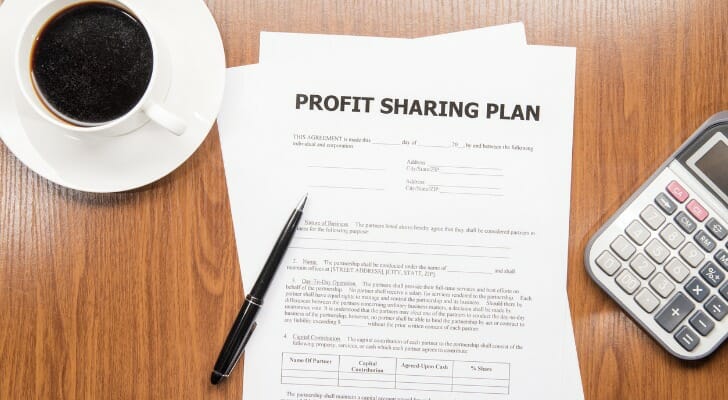Two of the most widely used employer-sponsored retirement plans are 401(k)s and profit-sharing. Both are tax-advantaged retirement plans, meaning that the IRS taxes contributions to these plans differently, if at all, but both have their differences. Here’s how each of these plans works.
Consider working with a financial advisor as you consider how to take advantage of these plans and boost your retirement prospects.
What Is a 401(k)?
A 401(k) plan, named after the section of the tax code that created it, is a tax-advantaged retirement account. These plans are only available when an employer offers them to employees or when self-employed people create their own plans.
In terms of structure, a 401(k) generally acts as an investment portfolio. The IRS puts some limits on the assets in which you can invest using a 401(k) plan. In turn, most 401(k) providers only allow you to invest in specific funds, which are buckets of investments. These many include target-date funds, which are specialized funds that change their holdings as you get closer to retirement.
Your employer sets up your 401(k) and offers a selection of investment options, such as mutual funds or target-date funds. You can choose how to allocate your contributions among these options based on your goals and risk tolerance.
Contributions to a traditional 401(k) are made with pre-tax dollars, reducing your taxable income for the year. You’ll pay taxes later when you withdraw the money in retirement. Employers can also contribute to your 401(k) and receive a tax deduction for their contributions.
The IRS limits the amount of tax-deductible money you can invest in a 401(k) plan each year. For 2026, this number is $24,500, jumping from $23,500 in 2025. Beyond that, you can contribute an extra $8,000 a year if you’re 50 or older. Starting in 2025, the catch-up contribution increases to $11,250 for those aged 60 to 63.
What Is a Profit-Sharing Plan?

Like 401(k) plans, profit-sharing plans are tax-advantaged retirement accounts that an employer runs for their employees.In a standard profit sharing plan, each employee account holds an investment portfolio of securities. The main difference is in how contributions are made.
Under a profit-sharing plan, the employer contributes an amount of money to each employee’s retirement plan account based on pre-defined criteria. The employer must use a standard formula for determining how much it will contribute to each employee’s retirement account, applied uniformly across the organization, and cannot make this decision on an ad hoc basis.
For example, an employer might say that each month it will contribute 10% of all corporate profits to employee retirement accounts. It is common for employers to establish contribution rules based on profits, hence the name “profit-sharing plan.”
Employers can also make this contribution using company stock. In this case, the value of any contribution comes from the value of the company’s stock at the time of the contribution.
Individuals cannot contribute to a profit-sharing plan. However, like a 401(k), this is a tax-advantaged account. The employer can deduct from its corporate taxes all contributions it makes to a profit-sharing plan up to a limit. For 2026, the number is $72,000 or 25% of compensation. This is an increase from $70,000 in 2025.
A company that uses a profit-sharing plan must include all employees and must use the same contribution formula for all employees. The IRS does allow some occasional exceptions to this rule, such as for employees who are very new to a company.
401(k) vs. Profit-Sharing: Key Differences
While both 401(k) and profit-sharing plans are tax-advantaged retirement accounts, they work differently in practice. A 401(k) allows employees to defer part of their salary into a retirement account, often with matching contributions from their employer. Profit-sharing plans, on the other hand, are funded entirely by the employer, with contributions based on a formula tied to profits, salaries or performance.
Contribution limits also differ. For 401(k) plans, employees can contribute up to $24,500 in 2025 ($32,500 with catch-up contributions if age 50 or older, or $35,750 if between 60 and 63). For profit-sharing plans, the maximum contribution is the lesser of $72,000 or 25% of compensation in 2026, with the employer responsible for deciding the amount each year.
Another difference is flexibility. With a 401(k), employees can choose how much to save and often select from a menu of investment funds. Profit-sharing contributions are decided solely by the employer and may vary from year to year depending on company performance. Employees cannot contribute to these accounts directly.
In some cases, companies may offer both options, allowing employees to save through their own 401(k) contributions while also benefiting from employer profit-sharing contributions. This combination can significantly increase retirement savings, especially over time.
Bottom Line

Under a 401(k), individuals contribute money to their retirement account and receive a tax deduction for this contribution. Their employer may also contribute and receive a tax deduction. Under profit-sharing, only the employer contributes to the retirement account. The employer establishes a uniform contribution rule for all employees’ retirement accounts. Then they receive a tax deduction for these contributions.
Tips on Retirement Planning
- If you have more questions about your retirement plan or prefer a hands-on approach, a financial advisor could help. Finding a financial advisor doesn’t have to be hard. SmartAsset’s free tool matches you with vetted financial advisors who serve your area, and you can have a free introductory call with your advisor matches to decide which one you feel is right for you. If you’re ready to find an advisor who can help you achieve your financial goals, get started now.
- Planning when you want to retire means you’ll need to have enough by then. With SmartAsset’s 401(k) calculator, you can review where your retirement accounts stand. Then, you can figure out if you have some catching up to do.
Photo credit: ©iStock.com/hatman12, ©iStock.com/CountDuckula, ©iStock.com/Drazen_
